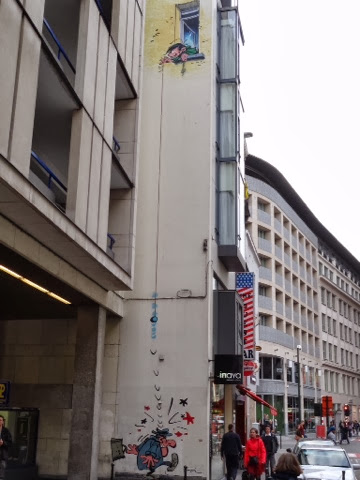The contents of the backpack are strewn around my apartment.
I'm being woken by the blinding Australian sunshine and a cacophony of birds at 4.45am.
It's 20 degrees at 7am.
Three tell-tale signs that I'm back home from holidays in Europe.
The journey home, along with the jetlag that wakes me in the midnight hours, has given me ample time to reflect on a fantastic week cycling along Germany's Rhine.
And also nine silly sightings that I remember from Germany.
1. If it's worth saying, it's worth saying in "ye olde" font
 |
| Just because it's hard to read, doesn't mean you shouldn't use it |
At some point a memo must have gone around the country saying that if you have a half-timbered, centuries-old house, you need to use the "ye olde" calligraphy font on its facade.
Sure, it's hard to tell if that is an "S", "T" or an "A", but it does look good.
2. There seems to be no medium-sized dogs in the country
 |
| This dog could have eaten us or drowned us in his slobber |
Tiny, yappy dogs? Check.
Massive, pure-bred dog/horses? Check.
Judging by the morning and evening parades of dogs and their owners, living in a German apartment doesn't mean you can't have a dog that's the same size as a Shetland pony. It makes sense. if you get tired of walking the dog, you can ride it home.
3. It's ice cream time all the time
 |
| Spaghetti ice cream: any time, any day |
I learnt that just because the temperature has hit single digits, that doesn't mean there won't be a queue for ice cream.
Or, even better, the "
spaghetti ice cream" craze that seems to have swept the nation.
4. People hiding in fields with rifles aren't birdwatching
 |
| There are foxes and hunters in those fields |
As we were casually cycling through a field one evening, we encountered a camouflaged man sitting in the tree. I asked him if he was birdwatching. He showed me his rifle and said he was shooting foxes. There's nothing quite as relaxing as cycling through the countryside to the sound of gunfire.
5. The "Stop Smoking" campaign is not working
 |
| What's German for "every cigarette is doing you damage"? |
Europe's always loved a cigarette or two. While smoking inside trains and buildings seems to have stopped, it feels like the vast majority still like to light up when they can.
6. Food and alcohol are cheap
Travelling on the "Pacific Peso" (Australia Dollar) I'm pretty much expecting everything, everywhere to be more expensive than home. But when you can have a hearty schnitzel and a beer for under 10 Euro (under AU$15) at a nice restaurant, you can't help but be pleasantly surprised at how food and alcohol are cheaper than in Australia.
As for the 90 Euro cent, single-scoop ice cream cone, that's just dangerous!
7. A lot of doors have strange chalk markings on them
 |
| The initials of the three wise men (C, M and B) in between the year's digits (2013) |
Initially I thought the chalk scrawl might have been left by sloppy tradesmen from when the door was installed. But this strange code, which was the same on every door, appeared on new and old doors.
Apparently it is a superstitious thing that happens at the beginning of each year. By putting the initials of the Three Wise Men (Caspar, Melchior and Balthazar) in the middle of the year's digits, the occupants are hoping for a blessed house during the next 12 months.
8. Alcohol-free beer features heavily on the menu
So I'm not a massive beer drinker, but I still can't quite wrap my head around the concept of alcohol-free beer. I can understand low-alcohol beer should you be the designated driver, but not alcohol-free beer that features on every menu I found in Germany.
I don't recall anyone saying: "Wow, this beer tastes great. Shame about that alcohol". I thought you put up with the taste of beer because of the alcohol!
9. FYI, "kunst" is German for "art"
Warning: potential for confusion when you hear someone say this.









































































